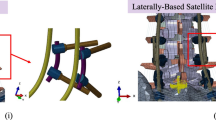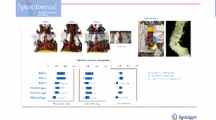Abstract
Purpose
The biomechanical performance of conventional multi-rod configurations (satellite rods and accessory rods) in pedicle subtraction osteotomies has been previously studied in vitro and using finite element models (FEM). Delta and delta-cross rods are innovative multi-rod configurations where the rod bends were placed only in its proximal and distal extremities in order to obtain a dorsal translation of the central part of the rod respect to the most angulated area of the main rods. However, the biomechanical properties of the delta and delta-cross rods have not been investigated. This study used FEM to analyze the effect of delta-rod configurations on the stiffness and primary rod stress reduction in multiple-rod constructs after pedicle subtraction osteotomy.
Methods
The global range of motion in the spine and the magnitude and distribution of the von Mises stress in the rods were studied using a spine finite element model described previously. A follower load of 400 N along with moments of 7.5 N in flexion/extension, lateral bending, and axial rotation were tested on the spine model. Initial breakage was created on the rod based on the maximum stress location. The post-breakage models were tested under flexion.
Results
Delta and delta-cross rods reduced more range of motion (up to 45% more reduction) and reduced more primary rod stress than other previously tested rod configurations (up to 48% more reduction). After initial rod fracture occurred, delta and delta-cross rods also had less range of motion (up to 23.6% less) and less rod von Mises stress (up to 81.2% less) than other rod configurations did.
Conclusions
Delta and delta-cross rods have better biomechanical performance than satellite rods and accessory rods in pedicle subtraction osteotomies in terms of construct stiffness and rod stress reduction. After the initial rod breakage occurred, the delta and delta-cross rods could minimize the loss of fixation, which have less rod stress and greater residual stiffness than other rod configurations do. Based on this FEA study, delta-rod configurations show more favorable biomechanical behavior than previously described multi-rod configurations.
Graphical abstract
These slides can be retrieved under Electronic Supplementary Material.







Similar content being viewed by others
References
Bridwell KH, Lewis SJ, Lenke LG (2003) Pedicle subtraction osteotomy for the treatment of fixed sagittal imbalance. J Bone Jt Surg Am 85:454–463
Dickson DD, Lenke LG, Bridwell KH, Koester LA (2014) Risk factors for and assessment of symptomatic pseudarthrosis after lumbar pedicel subtraction osteotomy in adult spinal deformity. Spine 39(15):1190–1195
Berjano P, Zanirato A, Compagnone D, Redaelli A, Damilano M (2018) Hypercomplex pedicle subtraction osteotomies: definition, early clinical and radiological results and complications. Eur Spine J 27(1):115–122
Berjano P, Damilano M, Langella F, Pejrona M, Lamartina C (2014) Osteotomies of the spine:“Technique of the Decade”? Eur Spine J 24(1):1–2
Berjano P, Bassani R, Casero G, Sinigaglia A, Cecchinato R, Lamartina C (2013) Failures and revisions in surgery for sagittal imbalance: analysis of factors influencing failure. Eur Spine J 22(6):853–858
Zanirato A, Damilano M, Formica M, Piazzolla A, Lovi A, Villafane JH, Bernjano P (2018) Complications in adult spine deformity surgery: a systematic review of the recent literature with reporting of aggregated incidences. Eur Spine J 27(9):2272–2284
Smith JS, Sansur CA, Donaldson WF, Perra JH, Mudiyam R, Choma TJ, Zeller RD, Knapp DR, Noordeen HH, Berven SH, Goytan MJ, Boachie-Adjei O, Shafferey CI (2011) Short-term morbidity and mortality associated with correction of thoracolumbar fixed sagittal plane deformity. Spine 36(12):958–964
Berjano P, Pejrona M, Damilano M, Cecchinato R, Aguirre MFI (2015) Corner osteotomy: a modified pedicle subtraction osteotomy for increased sagittal correction in the lumbar spine. Eur Spine J 24(1):58–65
Charles YP, Yu B, Steib JP (2016) Sacroiliac joint luxation after pedicle subtraction osteotomy: report of two cases and analysis of failure mechanism. Eur Spine J 25(Suppl 1):63–74
Smith JS, Shaffrey E, Klineberg E, Shaffrey CI, Lafage V, Schwab FJ, Protopsaltis T, Scheer JK, Mundis GM, Fu K-MG, Gupta MC, Hostin R, Deviren V, Kebaish K, Hart R, Burton DC, Line B, Bess S, Ames CP (2014) Prospective multicenter assessment of risk factors for rod fracture following surgery for adult spinal deformity. J Neurosurg Spine 21(6):994–1003
Palumbo MA, Shah KN, Eberson CP, Hart RA, Daniels AH (2015) Outrigger rod technique for supplemental support of posterior spinal arthrodesis. Spine J 15(6):1409–1414
Hyun SJ, Lenke LG, Kim YC, Koester LA, Blanke KM (2014) Comparison of standard 2-rod constructs to multiple-rod constructs for fixation across 3-column spinal osteotomies. Spine 39(22):1899–1904
Deviren V, Tang JA, Scheer JK, Buckley JM, Pekmezci M, McClellan RT, Ames CP (2012) Construct rigidity after fatigue loading in pedicle subtraction osteotomy with or without adjacent interbody structural cages. Glob Spine J 2(4):213–220
Smith JS, Shaffrey CI, Ames CP, Demakakos J, Fu K-MG, Keshavarzi S, Li CMY, Deviren V, Schwab FJ, Lafage V, Bess S (2012) Assessment of symptomatic rod fracture after posterior instrumented fusion for adult spinal deformity. Neurosurgery 71(4):862–867
Januszewski J, Beckman JM, Harris JE, Turner AW, Yen CP, Uribe JS (2017) Biomechanical study of rod stress after pedicle subtraction osteotomy versus anterior column reconstruction: a finite element study. SNI Spine 8:207
La Barbera L, Brayda-Bruno M, Liebsch C, Villa T, Luca A, Galbusera F, Wilke HJ (2018) Biomechanical advantages of supplemental accessory and satellite rods with and without interbody cages implantation for the stabilization of pedicle subtraction osteotomy. Eur Spine J 27(9):2357–2366
Hallager DW, Martin G, Dahl B, Harris J, Gudipally M, Jenkins S, Wu AM, Bucklen B (2016) Use of supplemental short pre-contoured accessory rods and cobalt chrome alloy posterior rods reduces primary rod strain and range of motion across the pedicle subtraction osteotomy level: an in vitro biomechanical study. Spine 41(7):E388–E395
Sellei RM, Kobbe P, Dadgar A, Pfeifer R, Behrens M, von Oldenburg G, Pape HC (2015) External fixation design evolution enhances biomechanical frame performance. Injury 46(Suppl 3):23–26
Finlay JB, Moroz TK, Rorabeck CH, Davey JR, Noume RB (1987) Stability of ten configurations of the Hoffmann external-fixation frame. J Bone Joint Surg Am 69(5):734–744
Cahill PJ, Wang W, Asghar J, Booker R, Betz RR, Ramsey C et al (2012) The use of a transition rod may prevent proximal junctional kyphosis in the thoracic spine after scoliosis surgery: a finite element analysis. Spine 37:E687–E695
Wilke HJ, Wenger K, Claes L (1998) Testing criteria for spinal implants: recommendations for the standardization of in vitro stability testing of spinal implants. Eur Spine J 7(2):148–154
Jager ZS, İnceoğlu S, Palmer D, Akpolat YT, Cheng WK (2016) Preventing instrumentation failure in three-column spinal osteotomy: biomechanical analysis of rod configuration. Spine Deform 4(1):3–9
Luca A, Ottardi C, Sasso M, Prosdocimo L, La Barbera L, Brayda-Bruno M, Galbusera F, Villa T (2017) Instrumentation failure following pedicle subtraction osteotomy: the role of rod material, diameter, and multi-rod constructs. Eur Spine J 26:764–770
Korupolu SC, Daniels AH (2018) Biomechanical comparison between titanium and cobalt chromium rods used in a pedicle subtraction osteotomy model. Orthop Rev 10(1):7541
Luca A, Ottardi C, Lovi A, Brayda-Bruno M, Villa T, Galbusera F (2017) Anterior support reduces the stresses on the posterior instrumentation after pedicle subtraction osteotomy: a finite-element study. Eur Spine J 26(Suppl 4):450–456
Berjano P, Blanco JF, Rendon D, Villafañe JH, Pescador D, Atienza CM (2015) Finite element analysis and cadaveric cinematic analysis of fixation options for anteriorly implanted trabecular metal interbody cages. Eur Spine J 24(7):918–923
Author information
Authors and Affiliations
Corresponding author
Ethics declarations
Conflict of interest
Dr. Pedro Berjano has received grants from NuVasive, DePuy Synthes, K2M, Speaker honorarium from Medacta and NuVasive. Dr. Ming Xu is former employee of NuVasive and owns stock of NuVasive. Mr. Thomas Scholl and Mr. Michael Jekir are current employees of NuVasive and own stock of NuVasive. Dr. Marco Damilano has received grants from NuVasive and K2M No honorarium for speaker. Dr. Claudio Lamartina is consultant for Depuy-Sythes, K2M, Medacta, NuVasive, Sintea, Zimmer, Deputy Editor for clinical science of European Spine Journal, and past chairman of AOSpine Board of Europe and Africa.
Additional information
Publisher's Note
Springer Nature remains neutral with regard to jurisdictional claims in published maps and institutional affiliations.
Electronic supplementary material
Below is the link to the electronic supplementary material.
Rights and permissions
About this article
Cite this article
Berjano, P., Xu, M., Damilano, M. et al. Supplementary delta-rod configurations provide superior stiffness and reduced rod stress compared to traditional multiple-rod configurations after pedicle subtraction osteotomy: a finite element study. Eur Spine J 28, 2198–2207 (2019). https://doi.org/10.1007/s00586-019-06012-2
Received:
Revised:
Accepted:
Published:
Issue Date:
DOI: https://doi.org/10.1007/s00586-019-06012-2




